David Lama und Conrad Anker erreichen im November 2015 als erste Expedition überhaupt die Headwall des 6907 Meter hohen Lunag Ri an der Grenze zwischen Nepal und Tibet.
Die Kombination aus einem noch komplett jungfräulichen Gipfel und anspruchsvoller Kletterei ist nicht alltäglich, sind doch gerade die unbestiegenen Berge klettertechnisch oft weniger reizvoll. Der Lunag Ri präsentiert sich aber von allen Seiten äusserst schwierig, weshalb auch bisher alle Expeditionen an diesem Granitgiganten – der letzte Versuch liegt mindestens zwei Jahre zurück – gescheitert sind. Der Österreicher David Lama wollte den Berg gemeinsam mit seinem Himalaya-erfahrenen Kletterpartner Conrad Anker aus Amerika über eine neue Route durch die Nordwestwand erstbesteigen.
Perfekte Wetterbedingungen bis zur Errichtung des Basislagers und während der Akklimatisierung ließen die Erwartungen des Duos entsprechend steigen. Nach nicht einmal zwei Wochen im Basecamp waren sie bereit für einen Gipfelversuch. „Weil im unteren Bereich der Wand kaum Schnee und Eis zu finden war, was auch die Steinschlaggefahr erheblich vergrösserte, mussten wir von unserer geplanten Aufstiegslinie absehen und eine andere Linie durch sehr viel steileres und schwieriges Gelände wählen.“
So fasste die österreichisch-amerikanische Seilschaft den Plan, über eine steile Felswand zum Nordwestgrat aufzusteigen, um von dort aus am nächsten Tag einen Gipfelversuch zu starten. Nach anspruchsvoller Kletterei erreichten die beiden am frühen Nachmittag den Grat, der durch schlechte Sicherungsmöglichkeiten und grundlosen Schnee gekennzeichnet war. Die Ausgesetztheit war dafür entsprechend spektakulär. „Die Kletterei war durchwegs anspruchsvoll und komplizierter als wir gedacht hatten. Es gab keine einzige Seillänge, die man einfach raufspaziert.“ so Conrad Anker.
Mit nur einem Tag akzeptablen Wetterbedingungen vor sich, startete das Duo nach einem eiskalten Biwak auf etwa 6000 Meter Höhe um 2 Uhr morgens den Gipfelversuch. Um schnelleres Vorankommen zu ermöglichen, beschlossen Lama und Anker alles auf eine Karte zu setzen und das Biwak Material zurückzulassen. Nach zwölf Stunden Kletterei über den ausgesetzten Grat trennte die Seilschaft nur noch die 300 Meter hohe Headwall vom heiß ersehnten Ziel. Doch es trat ein, was die beiden schon länger befürchtet hatten: Der Gipfel lag an diesem Tag außer Reichweite und ein oder vielleicht sogar zwei Biwaks ohne Zelt und Schlafsäcke bei -25°C und starkem Wind war einfach zu riskant. Auf dem Spiel standen weit mehr als nur Finger und Zehen. Auch wenn die Entscheidung schwer fiel, war man sich einig: Ein Rückzug war die einzig richtige Option.
Da der Österreicher mit nepalesischen Wurzeln und sein 53-jähriger Kletterpartner beim Abstieg zu einem zeitaufwändigem Mix aus Abseilen, Abklettern und Ausqueren gezwungen wurden, erreichten sie erst spät in der Nacht den Biwakplatz, der Schutz vor Kälte bot. Auch am dritten Tag mussten sie aufgrund von Steinschlaggefahr mit dem finalen Abseilen warten bis die Sonne weg war. „Hätten wir den Gipfel noch in der Tasche gehabt, wäre unsere Tour perfekt gewesen,“ fasst David Lama zusammen. „Dafür haben wir unsere Finger noch, die wir am Weg runter in unser Lager immer wieder in unseren Hosentaschen wärmen konnten und die auch bei unserem neuerlichen Versuch nützlich sein dürften. Diesen haben wir bereits für nächstes Jahr ins Auge gefasst.“
David Lama and Conrad Anker Interview
So what happened on Lunag Ri?
David Lama: “During the last years, my wish to return to the country of my father grew stronger. On one hand, I wanted to see the Nepali part of my family again; on the other hand I wanted to do some mountaineering. […] At the end of November, Conrad and I travelled to Nepal to try Lunag Ri, which had never been climbed before. Thanks to the perfect weather, we acclimatized quickly and within less than two weeks at the basecamp, we were ready. Because of the lack of snow and ice in the lower part of the face, we chose a line through a much steeper and more difficult terrain. On the first day, we climbed about 12 pitches to the ridge that we’d hoped would take us to the summit. On the second day, the weather forecast forced us to stake everything on one card and so we left our bivy [bivouac] with a light backpack at 3am. At around 3pm, about 400m below the summit, we had to accept that we were too slow on the consistently difficult climb to reach the summit that day. An open bivy – without tent or sleeping bag – was out of the question with temperatures around -25°C and winds of 50-70km/h, and we were forced to descend.”
Conrad Anker: “On November 12, 13 and 14, David and I gave the West Ridge of Lunag Ri an alpine style attempt. We led blocks of three pitches each and found it challenging climbing throughout. On the 13, we hoped to attain the summit from our single camp. Alas, the climbing was more complicated than anticipated and the final summit headwall was steeper than expected.”
Why choose each other as expedition partners?
DL: “From the first time we met, when we did a first ascent in Zion, it became clear that we work together well and I was sure that Conrad’s passion, like mine, would truly show on a mountain like Lunag Ri.”
CA: “I’m three years older than Rinzi, David’s father. While for many there might be a difference in generation, David and I are on the same page. We are dedicated to the pursuit of alpine climbing and have found a solid foundation to explore the mountains. David probably thinks I want to take too much stuff, which slows us down, yet affords safety and comfort. Aside from how many centimetre cube of beans to take, we are both in unison on how we climb – techniques and timing. And why we climb? We are unified and build upon each other’s strengths and support each other’s weaknesses.”
What did you learn from each other?
DL: “Conrad, despite his age, still has tons of motivation and energy. At the same time, he brings enormous experience to the table.”
CA: “David has Nepali feet. They are strong, balanced and a result of many generations of walking on the land (plus chicks dig ‘em). This connection to earth and the vertical world is the foundation of his climbing expertise. From a personality view point David is efficient in his conversation and what he expects of his partner. He speaks with clarity and intent. Perhaps this is part of being a Lama?”
You didn’t reach the summit – but to which extent was the expedition a success?
DL: “We climbed on completely virgin terrain up to 400m below the summit, a new high point on the mountain, and at the same time we could collect valuable information that will help us enormously for our next attempt next year.”
CA: “Expedition climbing is an adventure. Did we find adventure? Yes – lots of it. The difficulty of the climb has kept us at the top of our game. Without question it was a very positive and enriching experience. I simply love being in the mountains. Sharing this with a new group of friends made it that much more special.”
The highlight of the trip?
DL: “One of the last pitches that we climbed before retreating will remain engrained in my memory for a while. You follow a very thin crack that offers just enough room to jam the ice tool picks inside, while your crampons search for holds on the snow-plastered slabs below.”
CA: “On Saturday, November 7, we acclimatized on “Fox Peak” (translation from Sherpa / Tibetan). The summit at 5700m was quite airy, exposed on all sides. The sunset, with the sun to our backs, on Chomolungma (Everest), Lhotse and Makalu was exceptional. It provided a view of the Khumbu Himal that was new and refreshing. With a waning moon rising between the summit of Chomo and Lhotse we experienced the majesty of our planet.”
And the worst moment?
DL: “After about nineteen hours of full-on climbing and rappelling, we realized that we had rapped to about 50m below our bivy. After we pulled our ropes, one of them got stuck below us, so that we had to descend even further to free it before climbing upwards to our bivy.”
CA: “Friends of ours climbed a new route on the North Buttress of Tawoche. On the descent one of the climbers slipped and fell to his death. Upon hearing the news I was sad. One questions the meaning of life and, in particular, the challenges of alpine climbing in such moments. Aside from this, there were no bad moments. Life is a gift and each day we get to unwrap it anew.“
So what’s next for you both?
DL: “Winter is arriving and I have a couple projects in the Alps that I would like to climb over the next few months. And I think that the moment we decided we had to turn around, we both realized how much we wanted to reach the summit of Lunag Ri. We want to try it again next year.”
CA: “Over the next six months, I will train on water ice, alpine rock and in the gym in Montana and keep my eye on the goal: a return to Lunag Ri in 2016. As long as David is keen to climb with me, I’m more than motivated. I live for this and the two of us can attain the summit.”
Quelle: Servus TV / Mammut / Red Bull Content Pool

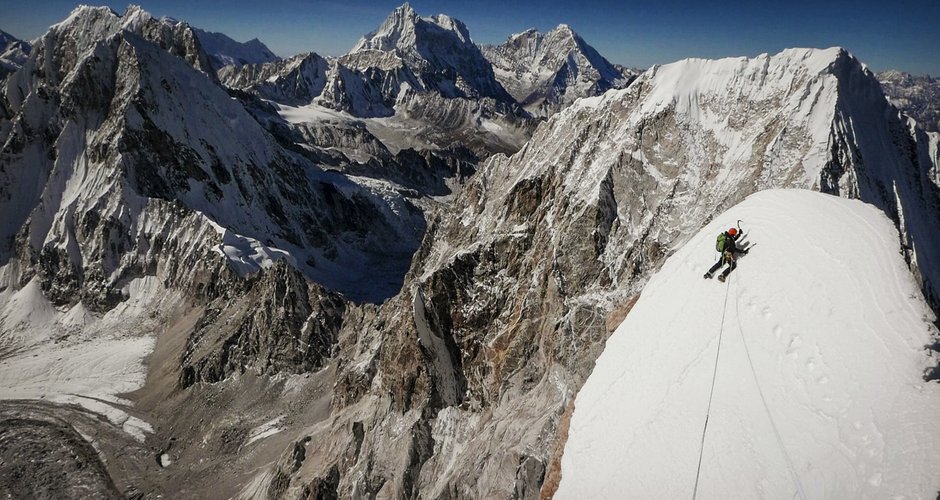 Conrad Anker climbs the Lunag Ri (6907m) in the Himalayas of Nepal on November 24, 2015 (c) Servus TV / Mammut / Red Bull Content Pool
Conrad Anker climbs the Lunag Ri (6907m) in the Himalayas of Nepal on November 24, 2015 (c) Servus TV / Mammut / Red Bull Content Pool
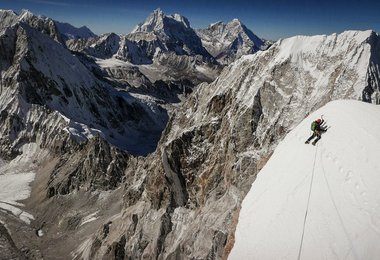
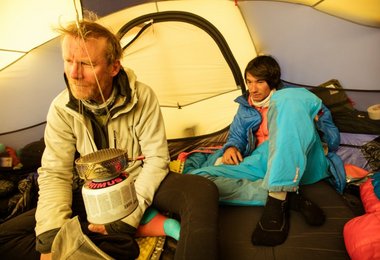
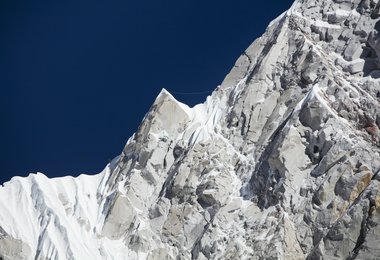
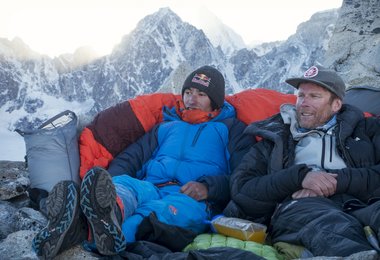
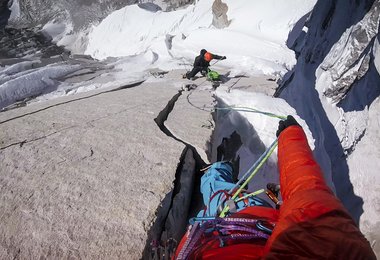
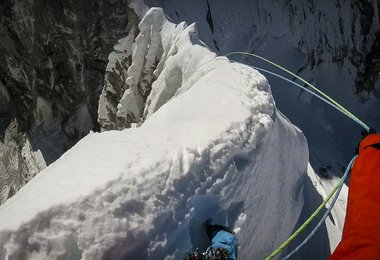
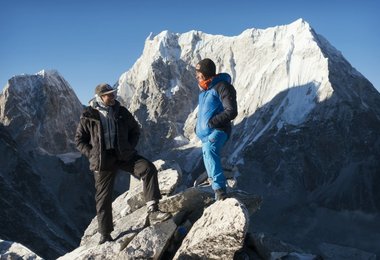



Kommentare